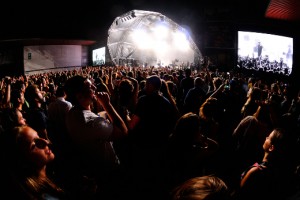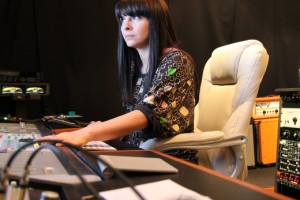The ABC’s of…EDM In The Studio: The Music Behind The Dance – The Chemical Brothers to Skrillex & Calvin Harris
The latest in a series by Michael Haskoor — also see the ABC’s of Avant Garde Rock, Electronic Rock, Punk/, Reggae, and Blues Rock.

EDM is big in every way — The audience digs into a concert at Sonar Festival on June 14, 2014 in Barcelona Spain (Image supplied by Shutterstock).
Music fans around the globe have all – at some point – fell victim to genre stereotyping in one form or another.
Whether it be through fashion trends, disposition, social class, drug use or any of the other million possible societal divisions, one thing we can be sure of is that EDM, more formally known as electronic dance music, hasn’t been exempt from this type of systematization.
From clubs to extensive festivals like Electric Zoo which just wrapped in NYC this weekend, EDM is a genre that has exploded in popularity among young people over the past decade – it planted its roots in the late 80’s and has developed into an unstoppable and lucrative scene, to say the least.
EDM is a genre that you either love or hate, and its fans will happily describe to you the powerful force that the music provides them: it regularly compels them to move every muscle in their body. Although many of the genre’s artists have taken to their laptops, the necessity of a knowledgeable producer and engineer in the studio has been the key to making what is good into great…and an Internet buzz into a live sensation.
Disco Debuts…
In the late 1960’s and early 70’s, electronic disco music can be said to have started it all, but it was not until the late 1970’s when electronic instruments started to be utilized in dance music.
Acts like Donna Summer and Gary Numan were at the forefront, using synthesizers, sequencers, drum machines and samplers to lay down the backdrop for some very catchy dance tracks. Proto-synth groups like Kraftwerk had their own role in influencing musical generations to come.
Established producers who could afford it, were soon able to get their hands on this type of equipment and were becoming quite successful within the genre, sparking a movement now known as electronic dance music, or EDM.
Disco music did not exist and succeed despite adversity however, a prime example of which is the famed Disco Demolition Night which took place at Chicago’s Comiskey Park in 1979 when anti-disco campaigner Steve Dahl was authorized by the White Sox to blow up a crate filled with disco records donated by sour rock and roll fans. (The stunt took place between the first and second games of a doubleheader against the Detroit Tigers. After turning into a massive riot and destructive anti-disco rally, the event ended up causing damage to the field and a forfeit by the White Sox.)
Then Dub to DJ’s…
Subgenres like Dub and synth-pop started to creep their way into the ‘80’s club scene, and dance music really started to explode into what it never was before, a way of life.
MIDI, which was now available, would be every producer’s go-to for the backing of a modern dance track. DJs began remixing old tracks, while house music and techno began to crop up, and the world was embracing the genre with open arms. Some of the more popular equipment and synthesizers being used included the Roland Jupiter-8 and SH-101, as well as the Yamaha DX7 & Korg M1. Bass synthesizers were also being utilized at this time.
It was in the late 1980’s and early 90’s when rave festivals and warehouse parties started to spring up. Techno and trance blew up and the genre was getting heavy radio attention to help it spread its wings. It became a scene and a way of life for listeners. These parties, the majority of which took place in New York City, were pioneered by the likes of DJs like Frankie Bones & DJ Scotto, whose efforts would later give rise to the idea of promotional groups who would front and manage these events.
Ultra Music Festival in Florida, an EDM event that is still very popular today, became one of them. New, young DJs with passion for the genre were now able to obtain their own equipment at a reasonable price because of the demanding market. They began to gain notoriety on their own – later ending up performing in front of a sold out crowd at one of these warehouse parties.
Although dance music groups like The Chemical Brothers, Fatboy Slim and The Prodigy were getting noticed by the big record labels and worldwide producers, EDM as its own distinct genre still occurred at a more underground level during this time. It was really Europe who was harnessing the techno and EDM style at the time, and acts like Daft Punk and David Guetta (who would collaborate with hip-hop acts like The Black Eyed Peas) were getting tons of attention. European festivals like Belgium’s Tomorrowland were increasing in attendance.
Mixing EDM: Best Practices
Production was getting very digital and mastering became the key behind the power and clarity of these immensely popular records. Engineers began experimenting with different forms of electronic sounds and helping to isolate the energy that fans of the genre craved.
Kerry Pompeo, a Brooklyn-based freelance engineer affiliated with 440 Sound Studios and Beatstreet Productions, tells SonicScoop about the essence of her EDM process:
“I work with some very talented up and coming producers and DJs (S.O.U.P., Live City, Gazzo) who are on point with their engineering and mix as they go,” she says. “It’s important for me to be transparent and carry out their vision. Generally, my job is to make the track sound bigger, wider and more moving.
“In order to achieve this, it’s essential to maximize the impact of individual sounds while having them take up the least amount of sonic real estate. I filter a LOT, especially low end—the kick and bass need that space and it helps lift synths and vocals. By removing irrelevant frequencies you free up energy and can be more effective in your compression stages.
“Side-chain the kick and it will hit you in the chest every time – tasteful use of this technique will add movement and space in your track. On the master, I use mid-side processing to mono all low end frequencies and create even more width for the vocals and synths.
“It’s important to reference current songs in the genre – if your track doesn’t sonically compete with what’s out there, chances are it won’t make it into a DJ’s set.”
Multi-Dimensional
The visual process (including lighting and stage effects) became an important component of the U.S. EDM, dubstep, and techno scenes, which all began to explode in the mid-2000’s. The Internet became an important outlet for the propagation of the genre through the spreading of songs and videos. Las Vegas became a place where these acts would showcase their music at large, poolside parties (usually in the form of residencies or multiple-day events).
These residencies were also becoming popular in New York City. The Electric Daisy Carnival was a popular EDM festival established in New York around that time as well, and it still carries a heavy buzz each year.
Nowadays, acts like Skrillex, Calvin Harris, deadmau5, Afrojack, and Diplo are just some of the current leaders of the genre. EDM has been getting negative attention from the media as of late for the prevalence of drug use during performances, particularly ecstasy or its purer form known as “molly” and there have been a number of fan deaths at these EDM festivals.
It has tied into the stereotype of the glow-stick-using, tie-dye and eccentric neon-outfit-wearing, drug and alcohol-abusing individual that so many describe as the typical EDM fanatic.
This overgeneralization, paired with the skyrocketing success of arena acts like Avicii and Swedish House Mafia, seems to be the current state of the genre to many. Surprisingly, its radio charisma (somewhat unnecessary since it has had such a bustling Internet presence) had been almost nonexistent until very recently, mostly available only on paid or private radio.
Watch It Grow

Expect EDM to keep us all D’ing. (Image supplied by Shutterstock).
Electronic dance music is a genre that will only grow and prosper. Whether it’s up your alley or not, EDM is music’s new way of looking at things.
It comes with a set of skills that all producers and engineers will need to know. Now that the music industry has embraced the use of electronic sounds and methods, imagine the endless possibilities out there. Will there be new ways to make the music that we all love to hear? Who will be the next unique EDM act to electrify a scene and genre that is already so powerful?
Put on your dancing shoes and get ready for your next EDM party, because they’re not going to stop any time soon.
– Michael Haskoor is a freelance music writer with a passion for music. He currently enjoys writing for Diffuser.fm and The Deli Magazine and will focus this series (done exclusively for SonicScoop) around the effect that studio production has had on different genres of music.
Please note: When you buy products through links on this page, we may earn an affiliate commission.









David Kowalski
September 2, 2014 at 9:30 am (10 years ago)Kerry is the best!
Kaya_Bailey
September 4, 2014 at 2:42 am (10 years ago)Great Article
Fredrik Andersson
September 4, 2014 at 4:49 pm (10 years ago)Chronologically truncated, but sums it up in a most accurate way, one of the better ones I have read.